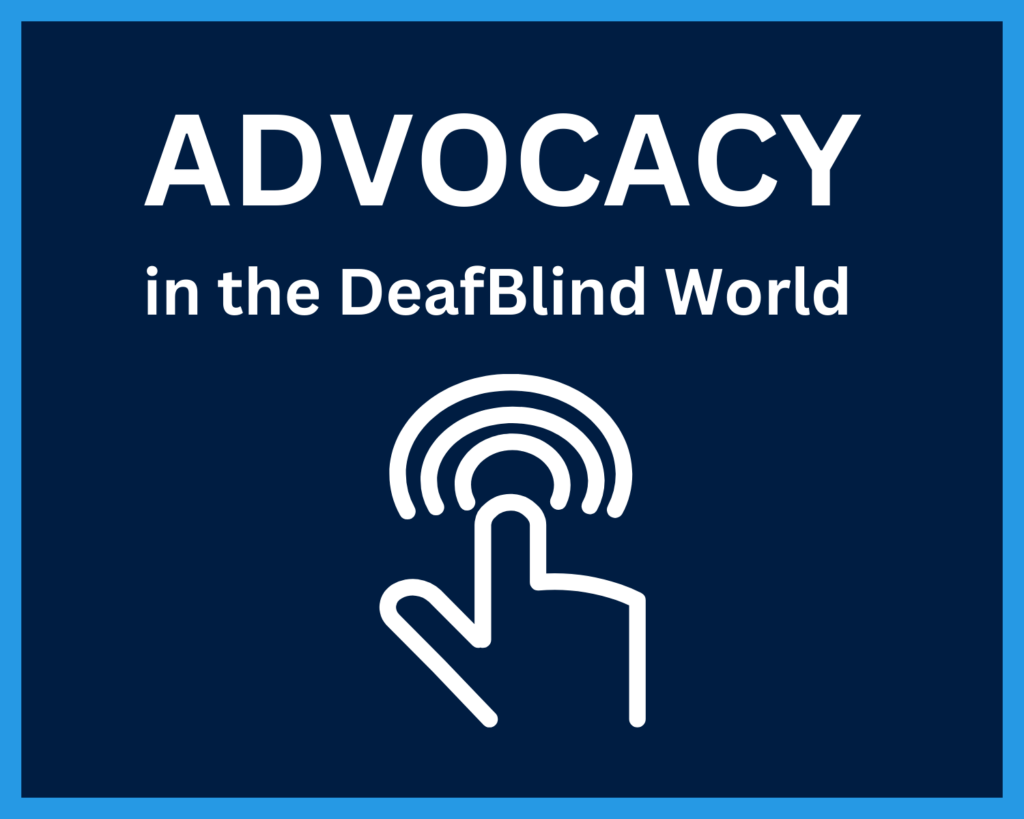Advocacy in a DeafBlind World (ADBW) – Video
Title slide: Advocacy in the Deaf-Blind World (ADBW) Ryan Odland
I’d like to give you definitions for advocacy and self-advocacy. Advocacy is when you provide support to others in the community. This can mean that you are the one to speak-up and be forthright with the groups needs. You could be asking for specific services such as: increased access to the community, improved communication efforts, or accessible transportation. Self-advocacy is when you take charge of your own life and speak up for yourself. This usually takes shape when you are describing your needs and providing justifications for those needs. These efforts are for the betterment of your own life. It’s important that you understand how to effectively advocate and self-advocate. The first step is knowing what each means and looks like in action. In order to get the positive outcomes or results you desire there are seven things you need to know.
Title Slide: Know Your Rights
The first being, “knowing your rights.” In order to know your rights, you have to be familiar with the laws that grant you those rights. Once you have an understanding of the law, you can then begin to ascertain how to apply the law to different scenarios. Keep in mind that you should become familiar with local, state, and federal laws. This way you maximize your potential to gain equal access to your community.
Title Slide: Know Yourself and Your Needs
Secondly, know your needs. You can’t advocate if you don’t know what you’re advocating FOR. You need to know what you can and can’t do as well as identify your limitations. Once they’ve been identified you begin to work to overcome them. In order to have more access to communication and transportation you have to identify your own needs and what works best for you. Let me provide you with an example to clarify what I mean. Let’s say you’re in a large round-table meeting. You might have some usable vision but you are not able to change focus quick enough to follow the meeting. So, as an accommodation, you request a tactile interpreter. This way you can easily and effortlessly be apprised of all that transpires in the meeting. When you make the ask, for an interpreter, make sure to clarify that you need a tactile interpreter who is familiar and comfortable working with deaf-blind individuals. If you get an interpreter that doesn’t have experience working with Deaf-Blind people you might not get the result you had hoped for. It’s best to find an interpreter with extensive experience.
Title Slide: Educate Those Around You
Third, you are a lifelong educator. You will often find yourself in situations where you are the first deaf-blind that audience has encountered. Deaf-blindness is a low-incidence disability. This means that we represent a very small portion of society. For practical purposes, it means you will most likely be the first deaf-blind person to many hearing-sighted individuals. It’s in these moments and interactions that you have the opportunity to educate the public about the deaf-blind community and culture. Through education you have the chance help to other deaf-blind people gain improved access to communication and transportation. These interactions help the public understand you and your perspective. With that understanding they can better help and support you. Many misunderstandings and frustrations can occur without these educational moments.
Know Who to Contact
Fourth, know the key players and the right people to contact. If a problem arises, you should know who to ask for help, or who to file a complaint with. Be respectful of the institutions chain of command. If there’s a problem that needs addressing do not immediately take it to the attention of the top dog. If you do this, you might be wasting your time. Typically, it is not the executive’s responsibility to handle things that happen on the ground floor. Instead, find the right supervisor or manager and bring your issue to them. Hopefully, they will be able to solve your issue.
Know How to File a Complaint
Fifth, know the proper procedures to file a complaint. As I said before, going straight to the top will more likely than not lead to confusion and misunderstandings. You will only be wasting your time because the execs will simply throw it back down to the bottom wrung. Doing this will decrease your chances of getting your desired outcome. It will also decrease your chances of getting improved access. If you follow the proper procedure and protocols you will eventually reach the person who has the authority to provide a remedy.
Title Slide: Be Tactful
Sixth, be tactful. Don’t be overly aggressive, impulsive, or rude. Be mindful of other people’s time. They are obviously taking the time to listen to you and to help the best they know how. Sometimes, people are simply unaware. So be tactful in your approach. Sometimes, staff members won’t be able to address all your concerns. They might not have the finances or authority to provide the perfect solution. In these times, remain calm, do not overpower them. Try and see how you can work together to arrive at your desired goal.
Title Slide: Compromise When Necessary
Lastly, be willing to compromise. Full access might not be feasible in certain situation. In fact, it’s often not possible and there are numerous reasons why this is the case. It might be too costly, they might not have the authority, or they might have the correct resource. When this is the case, you’ll have to make do with what’s reasonable to begin with. You might begin with compromise but down the road you might be able to get exactly what you had originally intended. Of course, what compromise looks like totally depends on the situation. What important is that you keep an open mind and be willing to compromise. In the end this attitude will take you much further than a “black or white” “all or nothing” attitude.
Title Slide: Conclusion
To conclude, this module went over how to best prepare for advocacy. We went over the 7 essentials to achieving positive outcomes as a result of advocacy. Here they are again:
- Know your rights
- Know yourself and your needs
- Know who to talk to
- Know the appropriate protocol
- Educate others
- Be tactful
- Be considerate of other people viewpoints
So now that we know how to prepare for advocacy…we have to learn how to actually advocate. This involves making an action plan detailing how to plan to approach the situation in a positive way. Being assertive and considerate of others will help you get the outcome you’re looking for.
Title slide: Stay Tuned…. Additional online trainings will be available soon.
[End of Transcript]



